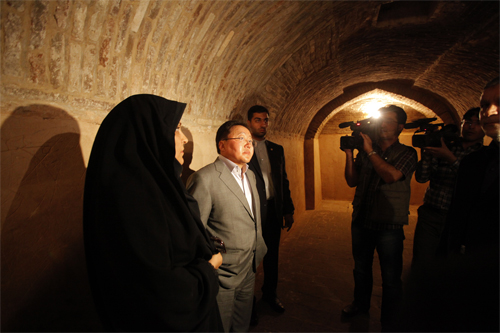ID :
253386
Thu, 08/30/2012 - 14:55
Auther :
Shortlink :
https://www.oananews.org//node/253386
The shortlink copeid
PRESIDENT VISITS TOMB OF ULZIIT KING

Ulaanbaatar, Mongolia /MONTSAME/The President of Mongolia, Ts.Elbegdorj visited a tomb of Mongolian King Ulziit in Soltaniyeh town of Zanjan region, Iran.
The tomb, built in 1302-1312, was registered in the UNESCO World heritage Sites in 2005.
When Ulziit King acceded to the throne, he greatly expand a small village of Khongor Ulaan, named it Soltaniyeh and announced it the capital of the lkhanate King. Soon Soltaniyeh city became a big trade center connecting Asia and Europe.
The tomb of Ulziit King weighs 200 tones, is 49 meter high, has double roofs with blue spherical top, and is considered the third biggest tomb in the world. The museum's authorities said that the tomb is being reconstructed, "we want to give it its initial look."
In the Book of Honoured guests Mongolia's leader wrote in the Mongolian script that he is glad to visit the tomb of "one of our forefathers Ulziit King" and thanked for keeping it until these days and for repairing.
The President told accompanying him media,“Chinggis Khaan's youngest son was Tului. Tului's son was Hulug who created Ilkhanate Mongol King of the Mongol Empire. Then, Mongolian Kings Abaga, Tuguldur, Raguun, Gaikhalt, Baidu, Gazan, Ulziit and Abuseyed governed Illkhanate in 1256-1344. It means that the Mongolians established the Ilkhanate King, drilled laws and implemented them. Olziit Khaan established peace in this region and restored the Great Mongol Empire of Chinggis khaan and Monkh khaan's era which used to spread from Mediterranean Sea to limitless steppes of Mongolia and China, and wrote about it in letters to Rome Pope and kings of France and England."
He also said that after 40 years, doors have been opened to cooperate in culture and sciences. He added that an original copy of Rashid-Ad-Din's “Sudriin chuulgan” book on history of Ilkhanate King will be given to the Mongolian side. The sides will exchange scientists, historians and students, the Ministries of Foreign Affairs will conclude contract, relations between cities and provinces will be created, for example, Zanjan region will have ties with Kharkhorum or Ovorkhangai aimag, he went on.
Yu.Tsedenbal, who ruled Mongolia for some 40 years, visited Iran in 1973, the Prime Minister of Iran visited Mongolia in 1976.
* * * *
The founder of the Ilkhanate dynasty was Hulagu Khan, grandson of Chingis Khaan and brother of both Mungke Khan and Kublai Khan. Mungke dispatched him to establish a firm Toluid control over the Middle East, and ordered him return to Mongolia when his task was accomplished. Taking over from Baiju in 1255 or 1256, he had been charged with subduing the Muslim kingdoms to the west "as far as the borders of Egypt." This occupation led the Turkmens to move west into Anatolia to escape from the Mongolian tribes. He established his dynasty over the southwestern part of the Mongol Empire that stretched from Transoxiana to Syria. He destroyed the Ismaili Nizari Hashshashins and the Abbasid Caliphate in 1256 and 1258 respectively. After that he advanced as far as Gaza, briefly conquering Ayyubid-Syria.
Mungke's death forced Hulagu to return from the Persian heartland for the preparation of Khuraltai (selection of a new leader). He left a small force behind to continue the Mongol advance, but it was halted in Palestine in 1260 by a major defeat at the battle of Ain Jalut at the hands of the Mamluks of Egypt. Due to geo-political and religious issues and deaths of three Jochid princes in Hulagu's service, Berke declared open war on Hulagu in 1262 and possibly called his troops back in Iran. According to Mamluk historians, Hulagu might have massacred Berke's troops and refused to share his war booty with Berke.
Hulagu's descendants ruled Persia for the next eighty years, tolerating multiple religions including Shamanism, Buddhism, and Christianity, ultimately adopting Islam as a state religion in 1295. However, despite this conversion, the Ilkhans remained opposed to the Mamluks (who had defeated both Mongol invaders and Crusaders). The Ilkhans launched several invasions of Syria, but were never able to gain and keep significant ground against the Mamluks, eventually being forced to give up their plans to conquer Syria, along with their stranglehold over their vassals the Sultanate of Rum and the Armenian kingdom in Cilicia. This was in large part due to civil war in the Mongol Empire, and the hostility of the khanates to the north and east. The Chagatai Khanate in Moghulistan and the Golden Horde threatened the Ilkhanate in the Caucasus and Transoxiana, preventing expansion westward. Even under Hulagu's reign, the Ilkhanate was engaged in open warfare in the Caucasus with the Mongols in the Russian steppes. On the other hand, the China-based Yuan Dynasty was an ally of the Ikhanate and also held nominal suzerainty over the latter for many decades.
Hulagu took with him many Chinese scholars, astronomers, and the famous Persian astronomer Nasir al-Din al-Tusi learned about the mode of the Chinese calculating tables. The observatory was built on a hill of Maragheh.
B.Oyundelger





